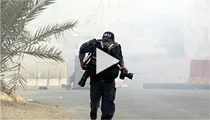Lebanon’s press climate, while better than its neighbors, suffered in 2012 as the uprising in Syria spiraled into civil war. In April, Syrian security forces shot and killed a Lebanese journalist covering the conflict from the Lebanese side of the border. Within the country, journalists faced significant risk while covering protests for and against the Syrian regime. In May and June, for example, nine journalists were attacked in four violent episodes during demonstrations. In September, the authorities detained for nearly a month a Lebanese-Palestinian journalist who frequently covered arms smuggling into Syria. In October, the rebel Free Syrian Amy abducted a Lebanese journalist working in Syria and held him captive for a week. Lebanese authorities negotiated his release.
Lebanon
» Syrian conflict leads to deterioration in press climate in Lebanon.
» Journalist is killed by Syrian sniper fire while reporting along the border.
Lebanon’s press climate, while better than its neighbors, suffered in 2012 as the uprising in Syria spiraled into civil war. In April, Syrian security forces shot and killed a Lebanese journalist covering the conflict from the Lebanese side of the border. Within the country, journalists faced significant risk while covering protests for and against the Syrian regime. In May and June, for example, nine journalists were attacked in four violent episodes during demonstrations. In September, the authorities detained for nearly a month a Lebanese-Palestinian journalist who frequently covered arms smuggling into Syria. In October, the rebel Free Syrian Amy abducted a Lebanese journalist working in Syria and held him captive for a week. Lebanese authorities negotiated his release.
CPJ documented one work-related fatality in Lebanon in 2012. Ali Shaaban, a cameraman for the Beirut-based television station Al-Jadeed, was struck in the chest by Syrian sniper fire while sitting inside a station vehicle in Wadi Khaled, a northern Lebanese town near the Syrian border, news reports said. CPJ documented at least 29 fatalities in 2012 related to the Syrian conflict. Both local and foreign journalists were among the victims.
| 24 | Syrian |
| 2 | French |
| 1 | Japanese |
| 1 | American |
| 1 | Lebanese |
Numerous journalists were assaulted while covering protests by supporters and opponents of the Syrian government, CPJ research shows. Several of the attacks were reported in May and June 2012 as Lebanese society became polarized by the conflict next door.
May 17: | Three crew members from Russia Today |
May 20: | Rona al-Halabi, Omar Khaddaj, and Elie Abu Asly of Al-Jadeed television |
May 21: | Naji Mazboudi of Al-Mustaqbal TV |
June 10: | Ghadi Francis of Al-Jadeed television, Firas Shoufi of Al-Akhbar |
Rami Aysha, a Lebanese-Palestinian journalist who contributed to several international news outlets including Time magazine, was arrested by Hezbollah forces on August 30 and transferred to military authorities. He was held until September 27. Aysha frequently covered arms smuggling from Lebanon to neighboring Syria.
Captured | Aysha, a Lebanese army lieutenant, and the officer's cousin were in a car on an airport road near the Hezbollah-controlled southern suburbs of Beirut when Hezbollah agents forced them at gunpoint into another car. |
Beaten | The agents took the three men to a Hezbollah office and held them for several hours, during which they were severely beaten. |
Detained | Aysha was transferred to a military police station in Beirut, where he was beaten by officers. |
Released | After much pressure from Beirut-based correspondents and press freedom groups, Aysha was released on bail on September 27, according to news reports. A criminal case on unspecified charges remained open. |
Lebanon has one of the highest Internet penetration rates in the region, according to the International Telecommunication Union. The country served as a hub for international and local journalists covering the conflict in Syria, with many of them slipping across the Lebanese border into Syria to report.

